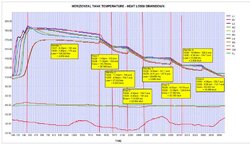Some may find this data interesting. This is a follow-up to Horizontal Tank - Stratification posted a little over a month ago. Look at that post for more information on the tank and sensors.
After a full tank charge, over a 3 day period I logged tank standby heat/btu loss and tank heat/btu's used to heat the radiant floor in my shop. Most standby losses are also to the shop. The tank has insulation consists of 6" fiberglass (R19) + 2" foam (R10) + 6" fiberglass (R19) on one exterior side wall and one exterior end wall, and all other tank box surfaces are interior and consist of 6" of fiberglass + 2" foam insulation.
Floor temperature (FL) ranged between 64-67F. Inside temperature (IS) ranged between 61-69F. Outside temperature (OS) ranged between 25-46F.
A few observations. 1) The boiler firing added considerable btu's into the heated space. During the charge period, inside temperature rose from 65-69F while outside temperature was falling from 44-37F and no heat was being drawn into the radiant floor. This data argues well for installation of a boiler system in the heated space rather than an out building.
2) Standby 1 was for 22.5 hours, and the only heat to the shop during this period was from standby losses of 4,819 btuh (less btu's lost to the outside walls).
3) The Draw btu's shown on the chart are only for the draw period. If Draw 1 and Standby 2 are combined, a period of 9 hours, then total heat load was 16,034 btuh. Similarly, for Draw 2 and Standby 3, total heat load was 17,514 btuh. Similarly for Draw 3 and Standby 4, total heat load was 9,340 btuh.
4) During the log period Standby 1 - Standby 4, heat load was 9,814 btuh at outside temperature of about 35F average and inside temperature of about 65F (deltaT= 30F). After the shop was built, I calculated heat load at 40,000 btuh (outside temp of -30F and inside temp of 65F. Logging data again during a cold winter period will provide the data to know what the heat load actually is.
5) Standby losses are proportional to deltaT tank temperature and the ambient surrounding temperature; the higher the deltaT, the higher the standby losses, and vice versa, which would be expected. But nearly all standby losses in my installation are into the heated space, the exception being losses through the nominal R48 outside walls and to some extent into the floor.
6) Standby losses at roughly 2,500 to 5,000 btuh are significant and also argue well for installation of a storage tank in the heated space.
7) The benefit of the 1000 gallons of storage is pretty clear. The total period covered by the chart was about 2 days, 18 hours, and only one boiler firing of about 5 hours with no boiler idling. The wood burned was all pine slab wood.
After a full tank charge, over a 3 day period I logged tank standby heat/btu loss and tank heat/btu's used to heat the radiant floor in my shop. Most standby losses are also to the shop. The tank has insulation consists of 6" fiberglass (R19) + 2" foam (R10) + 6" fiberglass (R19) on one exterior side wall and one exterior end wall, and all other tank box surfaces are interior and consist of 6" of fiberglass + 2" foam insulation.
Floor temperature (FL) ranged between 64-67F. Inside temperature (IS) ranged between 61-69F. Outside temperature (OS) ranged between 25-46F.
A few observations. 1) The boiler firing added considerable btu's into the heated space. During the charge period, inside temperature rose from 65-69F while outside temperature was falling from 44-37F and no heat was being drawn into the radiant floor. This data argues well for installation of a boiler system in the heated space rather than an out building.
2) Standby 1 was for 22.5 hours, and the only heat to the shop during this period was from standby losses of 4,819 btuh (less btu's lost to the outside walls).
3) The Draw btu's shown on the chart are only for the draw period. If Draw 1 and Standby 2 are combined, a period of 9 hours, then total heat load was 16,034 btuh. Similarly, for Draw 2 and Standby 3, total heat load was 17,514 btuh. Similarly for Draw 3 and Standby 4, total heat load was 9,340 btuh.
4) During the log period Standby 1 - Standby 4, heat load was 9,814 btuh at outside temperature of about 35F average and inside temperature of about 65F (deltaT= 30F). After the shop was built, I calculated heat load at 40,000 btuh (outside temp of -30F and inside temp of 65F. Logging data again during a cold winter period will provide the data to know what the heat load actually is.
5) Standby losses are proportional to deltaT tank temperature and the ambient surrounding temperature; the higher the deltaT, the higher the standby losses, and vice versa, which would be expected. But nearly all standby losses in my installation are into the heated space, the exception being losses through the nominal R48 outside walls and to some extent into the floor.
6) Standby losses at roughly 2,500 to 5,000 btuh are significant and also argue well for installation of a storage tank in the heated space.
7) The benefit of the 1000 gallons of storage is pretty clear. The total period covered by the chart was about 2 days, 18 hours, and only one boiler firing of about 5 hours with no boiler idling. The wood burned was all pine slab wood.


